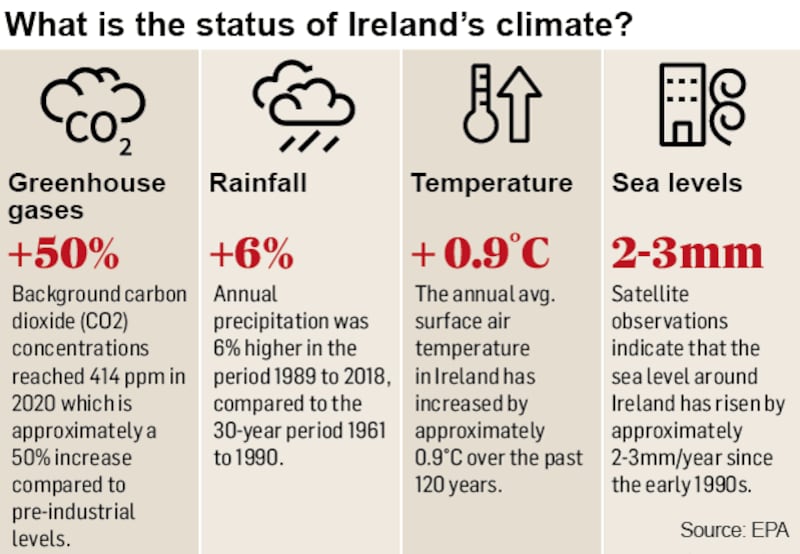Ireland’s climate indicators are all going in the wrong direction, the State’s environmental watchdog has warned in a landmark report confirming the country is getting wetter and warmer.
The Status of Ireland’s Climate study – the first comprehensive official assessment in eight years – lays bare a stark shift in the condition of the atmosphere, weather patterns, temperatures and sea levels.
Greenhouse gases contributing to global warming are at an all-time high. Compared to pre-industrial levels, carbon dioxide concentrations in the environment are up 50 per cent, methane has soared by almost 170 per cent and nitrous oxide concentrations are around 20 per cent higher.
Ireland’s rainfall was 6 per cent higher in the 30-year period between 1989 and 2018, compared to the previous three decades. The decade between 2006 and 2015 was the wettest on record.
Average air temperatures also continue to rise, up by 0.9 degrees over the last 120 years. A rise in temperatures has been recorded in all seasons throughout the year.
The report by University College Cork academics for the Environmental Protection Agency (EPA), Met Éireann and the Marine Institute, records that 15 of the top 20 warmest years on record in Ireland occurred since 1990.
The length of warm spells has also increased slightly over the past 60 years.
In line with global trends, sea levels are rising by about 2-3mm every year since the early 1990s.
In Dublin Bay, sweeping into the largest population centre on the island, levels have been heightening by about 1.7mm a year since 1938.
The report states that some “potentially harmful phytoplankton species” are growing in the seas around Ireland for longer periods of the year since 1990. They have been observed in almost all winter months since 2010.

Reality
Frank McGovern, chief climate scientist with the EPA, said the study “brings home the reality of global climate change to Ireland”.
“This effectively shows climate change is happening here and ecosystems are responding,” he told The Irish Times.
“We are seeing the impacts of global warming in our cities, towns, countryside and the ocean around Ireland. We are seeing the effects locally.
“The whole planet is changing and Ireland is changing with the planet. All of these indicators are going in the wrong direction.”
The report comes as the Government signals that a significant investment and focus on increasing the frequency of public transport will form part of its new plan to tackle climate change.
Senior sources said the plan will represent “a serious step up in terms of ambition and activity” in various sectors, although there is growing acceptance that agriculture and food production will not meet targets to reduce carbon emissions by 51 per cent by 2030.
Offshore wind and solar initiatives will do a lot of the “heavy lifting” in terms of planned cuts in emissions, sources said.
More acidic
According to the EPA report, the ocean is getting warmer and more acidic as a result of absorbing carbon dioxide pumped into the atmosphere by the burning of coal, oil and gas, threatening sensitive marine ecosystems, corals, shellfish and crustaceans.
While average global sea temperatures are rising by around 0.15 degrees a decade, temperatures at Malin Head in the decade between 2009 and 2018 were 0.47 degrees above the previous decade.
The higher rate of temperature rise is partly due to natural variations in the north Atlantic; however, the study says about half of the recent warming was directly attributed to global warming trends.
Inland, river flows are gathering pace across “most of the country” as a result of the increased rainfall, bringing with it the increased threat of flooding, trends from between 1972 and 2017 show.
However, the opposite appears to be occurring in the east and south of the country. The report states more recent data, for a more limited time period, indicates river flows are decreasing in the east and south of Ireland, with evidence in recent years pointing to an “increase in potential drought conditions, especially in the east”.
The study’s editors and lead authors were Walther Cámaro García and Ned Dwyer, of UCC’s MaREI energy, climate and marine research centre.








